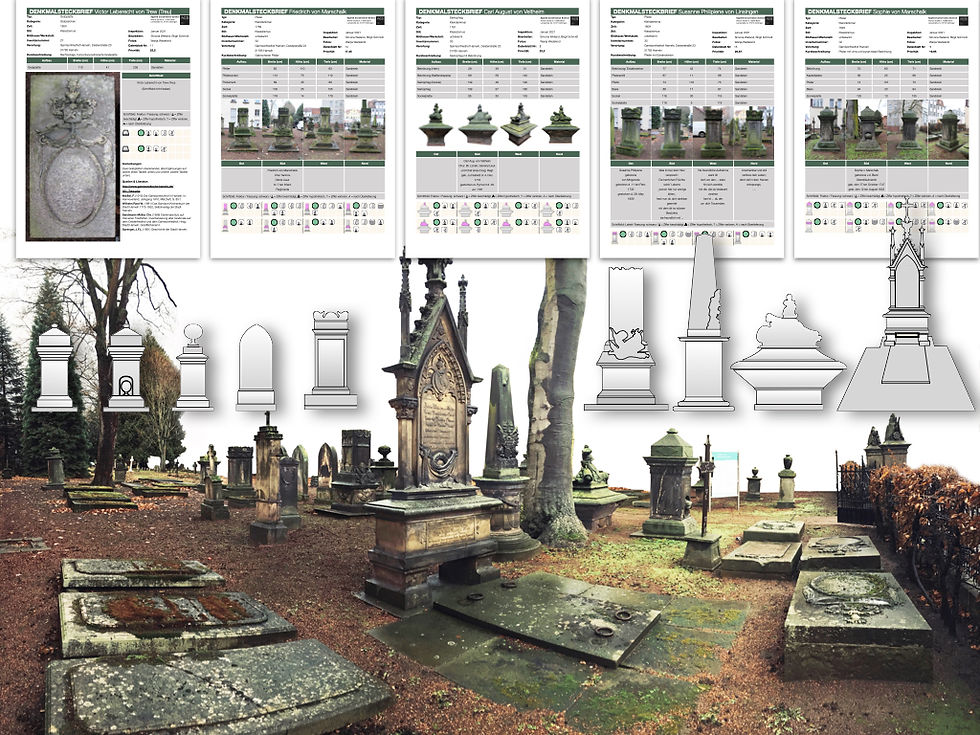ACS-Invent for the generals
- Wanja Wedekind
- Mar 19, 2021
- 3 min read

Historical and archeological sites, urban centers and parks show plenty of comparable monuments. Many of them, for example tombstones are in bad condition or have tended to be poorly maintained. For further treatment and risk management a system for safeguarding was developed and established by ACS now applied on tombs of the historical Garrison Cemetery in Hamelin.
The Garrison Cemetery
The Garrison Cemetery in Hamelin on the Weser River in Germany is an important monument to the cemetery culture of the 18th and 19th centuries.
It is home to a number of spectacularly designed monumental tombs of great artistic and historical significance.
Conservation Inventory of monuments
Historical cemeteries are good for studying various aspects of conservation. We can observe inscriptions on objects constructed over the centuries in a variety of different materials, mostly dateable, more or less comparable in dimensions and exposed to the similar environmental conditions. Christian cemeteries commonly preserve monuments from the late 18th century onwards in the north of Europe. Cemeteries of Islamic and Jewish originate from much earlier times. Necropolises are found in mostly all ancient cultures all over the world.
Historical cemeteries not only provide interesting documentation of local history and culture, but also offer a serious challenge for heritage conservation. Commonly, there may be no liv- ing relatives of the deceased, and consequently preservation of commemorative monuments becomes a responsibility of the general public.
The need to document cultural heritage and historic areas worldwide was first highlighted by the United Nations Education, Scientific and Cultural Organization, UNESCO (UNESCO 1976). Following on, the German national commission for heritage conservation provided further recommendations on this topic (Deutsches Nationalkomitee 1982), and the International Commission on Monuments and Sites, ICOMOS, adopted guidelines for the recording of monuments (ICOMOS 1996).
ACS-invent Based on these general guidelines the present with ACS-invent the authors developed a documentation system which attempts to collate all relevant information of cemetery objects, including the name of the monument or the buried person, together with details on the type of the monument, date of erection, current or historical inventory numbers, art- ist, sculptor or builder, location and a short inscription (figure). The date of inspection and the people in charge are documented. All the details concerning the dimensions of architectural building parts, the type of materials, varieties and their manufacture are tabulated. Photos of the object are inserted according to the date of erection of the monument. Below these photos is information on all inscriptions, including details on the font, font style, damaged or missing characters and extended words as well as their sources.
Key information for future planning is given by the evaluation of the state of preservation. Therefore, for each direction of the object, various symbols, forms and colors are defined to assist the characterization of different types of conditions, damage, weathering phenomena and their intensity. These symbols are organized in tables, each corresponding to the different object orientation. A square is used when further observation needs to be made; a circle underlines the need for action and a triangle highlights potential risks for the monument and public and the need for immediate attention. Weathering phenomena and descriptions follow the ICOMOS-ISCS illustrated glossary on stone deterioration patterns (Vergès- Belmin 2008). Each symbol type is linked to a value and can be highlighted with a graduated color. This color distribution shows the intensity of weathering and the percentage area of the monument that is affected. (fig. 1). Based on all values, a final number is calculated which is used to prioritize the object regarding the need for further action. This final value is highlighted with a signal color. On the bottom of each data sheet, references such as sources and literature are given as well as a short overview about the history of the object and its restoration (figure).
DEUTSCHES NATIONALKOMITEE, Empfehlung zum Erfassen und Dokumentieren bei Maßnahmen an Denkmälern, Schriftenreihe des Deutschen Nationalkomitees. Schriftenreihe des Deutschen Nationalkomitees für Denkmalschutz, Denkmalschutztexte - texte zum Denkmalschutz und zur Denkmalpflege, Bonn no 52 / 1996.
INTERNATIONAL COUNCIL ON MONUMENTS AND SITES (ICOMOS), Principles for the Recording of Monuments, Groups of Buildings and Sites. Ratified on the 11then ICOMOS general assembly, Sofia, Octobre 1996.
UNESCO „UNESCO recommendation concerning the safeguarding and contemporary role of historic areas“. Passed on 19th general assemble of UNESCO, 26. November 1976, Nairobi.
VERGÈS-BELMIN, V. (éd.), ICOMOS-ISCS: Illustrated glossary on stone deterioration pattens, Champigny-sur-Marne, 2008.




Comments